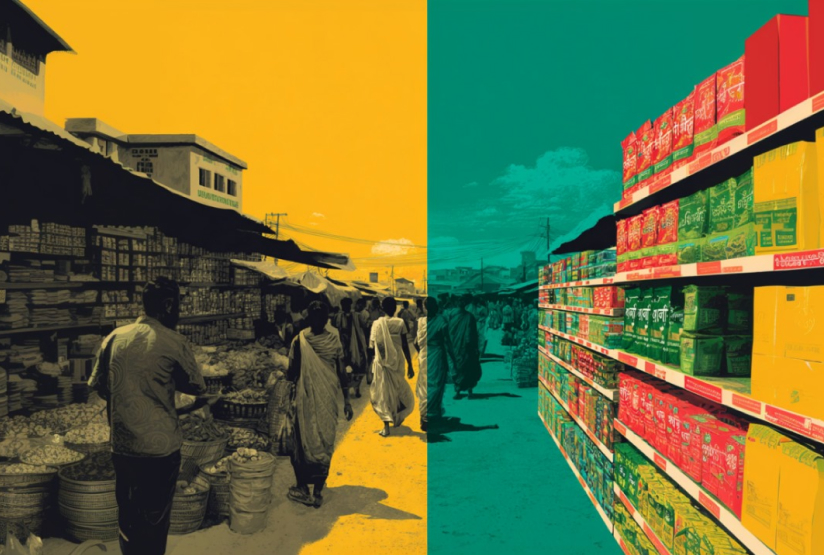

Why Bangladesh’s DTC Brands Can’t Go Global: The Unspoken Regulatory Roadblock

Newsletter
Bangladesh’s startup scene is evolving, with fintech apps reshaping transactions to logistics players weaving together last-mile delivery networks. The country’s digital economy is growing, and so is its digitally savvy middle class, which is shopping online in record numbers, attracting a younger and more adventurous consumer base.
Yet amid this progress, one category of startups remains notably underrepresented: direct-to-consumer (DTC) brands, especially in the food and personal care segments. While India’s Paper Boat is found in the UAE and Singapore, Vietnam’s Marou Chocolate features in gourmet stores across Paris, and Indonesian beverage startup Kopi Kenangan is expanding its café model beyond Southeast Asia, Bangladeshi consumer brands rarely make it past the diaspora shelves in New York or London.
The standard explanations are familiar: limited funding, a small domestic market, or a lack of founder mindset. But there’s a less-discussed, yet structurally significant reason behind this export bottleneck: Bangladesh’s packaging and labeling regulations, particularly those enforced by the Bangladesh Standards and Testing Institution (BSTI).
What Is DTC—and Why It Matters
DTC brands are built on a relatively simple but powerful model: cut out the middlemen and sell directly to consumers. By controlling distribution, marketing, and storytelling end-to-end, these companies often rely on digital and owned channels, such as social media platforms, branded online storefronts, mobile apps, physical experience centers, and pop-up stores and events to reach their customers. They build brands around values like sustainability, health, or heritage, and they scale by tapping into both local and international demand through lean supply chains and strong digital narratives.
Unlike traditional manufacturing or export businesses that depend on trade intermediaries or brick-and-mortar retailers, DTC brands can launch with small product batches, leverage social media for brand-building, and expand into new geographies without setting up physical distribution channels. In short: they’re asset-light, story-rich, and scalable.
Investor sentiment continues to reinforce the relevance of the DTC model. Firms like Forerunner Ventures have built standout portfolios around storytelling-driven brands such as Glossier, Bonobos, and Outdoor Voices. Sequoia Capital China is repositioning companies like We11done toward fully integrated DTC models, while Accel has backed digitally native consumer brands such as Nykaa, Licious, and Peloton.
India’s DTC sector has demonstrated significant growth on the global stage. In 2022, India’s DTC market was valued at around US$12Bn, with projections estimating it could reach US$60Bn by 2027, driven by rising digital penetration and consumer demand for authentic, value-driven brands.
Several homegrown Indian DTC brands have successfully expanded beyond India by leveraging diaspora demand, compelling brand stories, and robust export logistics. For example, Paper Boat (now part of Hindustan Unilever) has entered markets such as the UAE and Singapore by capitalizing on its nostalgic, heritage-inspired beverage flavors. Mamaearth, a natural skincare and personal care brand, exports to the Middle East, Europe, and North America, targeting the Indian diaspora with its toxin-free and sustainability-focused products. Bombay Shaving Company, specializing in men’s grooming, has penetrated the US and GCC markets, offering its products through both e-commerce and retail stores abroad. Meanwhile, boAt, known for its affordable audio wearables, has gained traction across GCC countries, Southeast Asia, and select Western markets by consistently branding itself as an urban tech solution.
These brands stand out due to a combination of well-established logistics networks, story-led differentiation that resonates across markets, and a diaspora-first approach that eases global entry by targeting communities with cultural affinity. Together, these factors also highlight the export-readiness and global potential of India’s DTC brands.
While DTC funding is modest in comparison to other dominant sectors like AI or enterprise SaaS, its sustained share demonstrates that investor appetite remains for differentiated, export-ready consumer brands with strong retention economics.
Bangladesh has no shortage of product categories that could thrive under a DTC model—from tea, snacks, and spices to handmade beauty products and craft beverages. These aren't just commodities; they're deeply tied to Bangladesh’s cultural identity and artisanal heritage. For instance, tea from Sylhet, with its distinct aroma and flavor, could appeal to premium tea drinkers abroad, and traditional snacks like chanachur, shingara, or puffed rice, often made with family recipes, could be reimagined as artisanal or diaspora-focused packaged goods.
In beauty and wellness, Bangladesh possesses an abundance of natural ingredients like turmeric, neem, coconut oil, and hibiscus, which could be utilized to create skincare brands focused on sustainability and clean formulations. Botanical drinks or craft beverages made from local herbs or fruits could tap into the functional beverage trend globally. Heritage textiles like Jamdani or Nakshi Kantha could serve as lifestyle products, particularly when presented with strong storytelling around craftsmanship and community impact. Despite this potential, Bangladeshi DTC brands remain notably confined to the local market. So what’s keeping these brands from becoming household names beyond borders?
The BSTI Packaging Trap
In 2021, BSTI introduced updated packaging and labeling requirements that mandate Bangla-language text for every packaged product sold in the country. This includes key information such as product name, manufacturer, net weight, maximum retail price, and expiry dates. The intent behind this regulation is to ensure consumer protection and transparency, which is understandable in the domestic context.
The issue, however, is that there is no legal exemption for products intended solely for export. Any consumer packaged good (CPG) made in Bangladesh, even one destined for Amazon UAE or Carrefour Qatar, must comply with domestic packaging rules unless it is exported in bulk through industrial B2B channels. For DTC brands—those that sell in small batches, often online—this lack of an “export-only” exemption is an enormous operational constraint.
It effectively forces startups to create and maintain two separate packaging lines: one for the domestic market and one for international sales. That might be feasible for a large-scale manufacturer. But for an early-stage brand producing artisan snacks or organic skincare, dual packaging drives up costs, fragments inventory, and introduces unnecessary regulatory risk. This alone creates a barrier to global scaling for most startups.
The BSTI Logo Doesn’t Travel
The problem goes beyond language. Many food and cosmetic products also require the BSTI certification mark on their packaging. While this stamp may offer credibility in local markets, it holds no value and, in fact, often raises questions in international retail environments.
Consider a Bangladeshi spice blend competing on a shelf in Dubai or a skincare product trying to sell in Europe. Next to competitors with USDA Organic, FDA-compliant, or Halal UAE certifications, a BSTI logo is not just unfamiliar—it can suggest that the product was made solely for a domestic market and not for global distribution. This weakens trust and undermines the brand’s perceived legitimacy, even if the product itself meets high standards.
In comparison, India’s food standards authority (FSSAI) permits packaging in English or Hindi and does not require the FSSAI logo for products designated for export. This gives Indian DTC brands the flexibility to use a single packaging SKU across both local and global channels, lowering production costs and maintaining a consistent brand identity.
The result? Bangladeshi brands struggle with costly compliance workarounds, while their regional counterparts build seamless cross-border operations from day one.
The Downstream Effects: Cost, Compliance, and Capital
These regulations create a cascading set of challenges. The most immediate is cost: maintaining separate production lines increases printing expenses, storage requirements, and packaging waste. Operationally, it creates room for error in inventory management and fulfillment, especially problematic for startups that rely on lean teams and minimal overhead.
From an investment perspective, this also dampens appeal. Investors evaluating consumer brands may question whether a product can scale globally using domestic resources. If the answer is "not without doubling packaging costs and navigating regulatory hoops," the conversation may stall. For a DTC brand, scalability is the product. If it’s absent, funding rarely follows.
Moreover, this bottleneck limits where Bangladeshi brands can sell. Without packaging that meets international retail expectations, most startups end up targeting niche diaspora shops, where price pressure is high and brand loyalty is low. They rarely break into mainstream e-commerce channels, much less the shelves of regional supermarkets abroad.
Beyond Regulation: The Other Missing Pieces
Regulatory constraints are only part of the story. Several other gaps in the ecosystem compound the challenge:
1. Weak Brand Identity
Many local DTC brands underinvest in storytelling, visual branding, and packaging design. While Vietnamese, Indian, or Kenyan startups are exporting not just goods but narratives—built around single-origin sourcing, sustainability, or cultural pride—Bangladeshi brands often lack a distinct positioning that can travel.
2. No Infrastructure for Small-Batch Exports
Exporting DTC products, particularly perishable or niche items, requires access to cold chain logistics, customs clearance support, and small-batch-friendly fulfillment centers. These are either underdeveloped or nonexistent in Bangladesh. For founders trying to ship a dozen jars of ghee or herbal hair oil to Dubai or London, the barriers are often insurmountable.
3. No IP, No Unique Selling Point
Too many Bangladeshi DTC/CPG startups are selling generic products: basic spices, dried fish, pickles. Without product innovation, strong formulation R&D, or a unique narrative, they blend into the background on a global shelf crowded with similar SKUs and struggle to command premium pricing abroad.
4. No National Promotion or Export Strategy for Consumer Brands
While India has “Make in India” and export subsidies for promising CPG companies, and Vietnam runs the “Vietnam Value” initiative to boost national consumer brand visibility abroad, Bangladesh offers little more than a BSTI certificate and a congratulatory Facebook post. There is no formal initiative to nurture, showcase, or subsidize export-ready DTC brands.
What Can Be Done
The path forward doesn’t require dismantling standards, but rather modernizing them for a more global context. Here are six actionable reforms that can unlock export potential for Bangladesh’s DTC sector:
- Allow Export-Only Labeling Flexibility
Permit English-only packaging for SKUs that are not intended for domestic sale. This would eliminate the need for dual packaging lines and reduce costs. - Redesign the BSTI Mark for International Acceptance
Create a modern, bilingual (or English-only) BSTI certification mark aligned with global expectations. This small design shift can have a large impact on perceived product credibility abroad. - Enable Smart Labeling Through QR Codes
Allow DTC brands to use QR codes or digital product passports to display regulatory or localized information online, reducing physical labeling constraints and promoting traceability. - Align BSTI with International Standards Bodies
Pursue mutual recognition agreements with agencies like the FDA (U.S.), EFSA (EU), or SFDA (Saudi Arabia), so BSTI-certified products can be fast-tracked in key markets. - Establish a DTC Export Facilitation Hub
Under Startup Bangladesh, BIDA, or EPB, a dedicated center could offer training, compliance guidance, logistics support, and export readiness toolkits for early-stage brands. - Launch a National Campaign to Promote Bangladeshi Consumer Brands
Much like “Make in India,” Bangladesh needs a coordinated export branding campaign—Built in Bangladesh or A Product of Bangladesh—focused on supporting 50–100 promising brands with packaging grants, export fair access, and global PR support.
Let Founders Package Success—Not Just Products
This is no longer just a packaging conversation. It’s a growth opportunity hidden in plain sight. If Bangladesh wants to build a consumer economy that competes beyond its borders—one that earns foreign currency, tells its story through design, and expands its soft power—it must give founders the regulatory space to operate globally.
In a region where global brand-building is accelerating, Bangladesh can’t afford to play by rules written for a different era. The packaging may be small, but the implications are big.




















.jpg)
.jpg)





.jpeg)



.jpg)


















.jpg)


.jpg)
.jpg)

.jpg)
.jpg)


















.jpeg)












..jpg)
..jpg)



.jpg)






